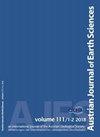Crustal geomagnetic field and secular variation by regional and global models for Austria
IF 1.1
4区 地球科学
Q2 Earth and Planetary Sciences
引用次数: 0
Abstract
Abstract Using 12-year-long series of data (2001-2012) from geomagnetic observatories and repeat stations in Austria and its neighboring countries, a regional spatial-temporal (ST) model is developed based on the polynomial expansion consisting of latitude, longitude, and time of the geomagnetic field components and total magnetic field F. Additionally, we have used three different global models (CHAOS-5, POMME-9, and EMM2015), which are built on spherical harmonics up to a maximum degree Lmax and give the core field and crustal field separately. The normal field provided by the ST model and its “model bias”, which comprise the residuals of the differences between measured and predicted values, are calculated and the respective maps are shown. The residuals are considered an estimate of the local crustal field. In the case of global models, we have applied for each of these three methods to calculate the “model bias”: residuals of the differences between observed values and predicted values of the model, residuals of the differences between observed values and core field values of the model, and the average bias for the period 2001-2012. The normal field of the region of Austria provided by each global model is also calculated. Generally, the regional and global models yield relatively similar crustal fields for the Austrian region, especially when the first method is used. The normal fields calculated by them are in good agreement with each other. Each of the global models directly provides the crustal field, and they are compared with the aeromagnetic data provided by aeromagnetic surveys over the Austrian region. The ST model is in better agreement with aeromagnetic data. We have also analyzed the secular variation over the region, which is calculated from the rate of change of normal field given by the ST and global models.奥地利地壳地磁场与区域和全球模式的长期变化
摘要利用奥地利及其邻国地磁观测站和重复站的12年系列数据(2001-2012),基于地磁场分量和总磁场F的纬度、经度和时间多项式展开,建立了区域时空(ST)模型,我们使用了三种不同的全球模型(CHAOS-5、POMME-9和EMM2015),它们建立在最大程度Lmax的球面谐波上,并分别给出了核心场和地壳场。计算ST模型提供的正态场及其“模型偏差”,包括测量值和预测值之间差值的残差,并显示相应的映射图。残差被认为是对局部地壳场的估计。在全局模型的情况下,我们应用了这三种方法中的每一种来计算“模型偏差”:模型的观测值和预测值之间的差异残差、模型的观测值和核心场值之间的差值残差以及2001-2012年期间的平均偏差。还计算了每个全球模型提供的奥地利地区的正态场。一般来说,区域和全球模型为奥地利地区产生了相对相似的地壳场,尤其是当使用第一种方法时。它们计算出的正态场相互吻合。每一个全球模型都直接提供了地壳场,并与奥地利地区航空磁测提供的航空磁测数据进行了比较。ST模型与航磁数据吻合较好。我们还分析了该区域的长期变化,这是根据ST和全局模型给出的法向场的变化率计算的。
本文章由计算机程序翻译,如有差异,请以英文原文为准。
求助全文
约1分钟内获得全文
求助全文
来源期刊

Austrian Journal of Earth Sciences
Earth and Planetary Sciences-Paleontology
CiteScore
3.10
自引率
0.00%
发文量
0
审稿时长
>12 weeks
期刊介绍:
AUSTRIAN JOURNAL OF EARTH SCIENCES is the official journal of the Austrian Geological, Mineralogical and Palaeontological Societies, hosted by a country that is famous for its spectacular mountains that are the birthplace for many geological and mineralogical concepts in modern Earth science.
AUSTRIAN JOURNAL OF EARTH SCIENCE focuses on all aspects relevant to the geosciences of the Alps, Bohemian Massif and surrounding areas. Contributions on other regions are welcome if they embed their findings into a conceptual framework that relates the contribution to Alpine-type orogens and Alpine regions in general, and are thus relevant to an international audience. Contributions are subject to peer review and editorial control according to SCI guidelines to ensure that the required standard of scientific excellence is maintained.
 求助内容:
求助内容: 应助结果提醒方式:
应助结果提醒方式:


